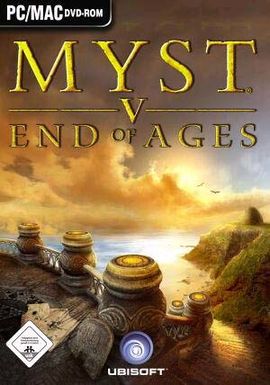Myst V: End of Ages
This article is written from an OOC point-of-view. Events and elements in the D'ni Universe are regarded as fictional. |
 | |
| Developer | Cyan |
|---|---|
| Publishers | Ubisoft |
| Genres | graphic adventure, puzzle |
| Mode | single-player |
| Media | DVD-ROM |
| Input | keyboard, mouse |
| Preceded by | Myst IV: Revelation; Uru: Path of the Shell |
| Followed by | Myst Online: Uru Live |
Myst V: End of Ages (codenamed Sasquatch and Something Else) is the "grand finale" of the five-part Myst series of computer games, after Myst, Riven: The Sequel to Myst, Myst III: Exile and Myst IV: Revelation. Despite this, it clashes with some of its predecessor's themes on both technical and storyline levels, and it also ties in with the spin-off Portal:Uru games, Ages Beyond Myst, To D'ni and The Path of the Shell.
Development
RAWA has several time-lapse videos[1] showing the progress of the game's development between Summer and Winter 2004 (after which beta testing began).
Premise
The exact setting of Myst V in relation to its predecessors is rather ambiguous. While it is marketed as a Myst game, it takes place in present time, roughly around its release (late 2005): after the events contained within Uru: Ages Beyond Myst (late 2003), To D'ni and The Path of the Shell (spring 2004), but before the revamped Myst Online: Uru Live (late 2006 and beyond).
This gap of about two centuries made it unclear if the character played is the Stranger of the other Myst games: since that person was presumably human, they would probably be dead by now, barring time travel. This question had been deliberately left unanswered by Cyan, to encourage fan speculation and to be explored in further detail later on. On September 11, 2007, Dr. Watson indirectly revealed that he, in fact, was the actual protagonist.[2]
The player is employed by Yeesha to go on a journey across four Ages, finding Slates on each Age that control the bahro. At each of these Ages, the player is treated to a speech by the D'ni man, Esher, who has deluded himself into believing he is the Grower. At the end, each of the four Slates are used to free the Tablet, and you have the choice of giving it to Yeesha, Esher, or a third, somewhat less obvious choice.
Ages
Myst V takes place in seven areas: K'veer, the Great Shaft, Direbo, Tahgira, Todelmer, Noloben, and Laki'ahn. Releeshahn is also glimpsed at the game's "good ending" finale, but it is cinematic only and cannot be explored.
Limited Edition
A Limited Edition contained the soundtrack, which later became separately available.
Differences
Other Myst series games
End of Ages differs from its Myst series predecessors as follows:
Graphics
- Myst (and Myst Masterpiece Edition) uses single-perspective pre-rendered nodes. All animation is done by embedding video clips, and characters are actual live-action movies with performing actors.
- Riven uses an increased amount of animation, but similar techniques. However, the water is instead real-time-generated with a comparably primitive algorithm.
- Exile allows for 360-degree panorama panning, although still merely through stitched-together, pre-rendered-image nodes. It does similar real-time-generated water animation as Riven.
- Revelation uses similar panning, but increases the use of real-time pieces for some animated aspects of the scene.
By contrast, End of Ages uses almost no pre-rendered data whatsoever, instead using full real-time 3d scenes, and relying on pixel shaders for water and grass animation—making for a much more scalable result: looking significantly worse on old machines, but arguably superior to preceding games on very modern computers. This makes for a recent source of negative reviews; many people's perception of the game is changed tremendously by presenting it on a more capable computer setup. Even the characters appearing are rendered in real-time, with the only exception being their faces, which are pre-recorded video files for added realism.
While realMyst uses an older version of the same real-time 3D engine as End of Ages, very few actually played it, making End of Ages the first widespread Plasma-based experience of a Myst game (not counting Uru).
Timeline
Myst, Riven, Exile and Revelation are all situated around the late 18th and early 19th century. This leaves a gap of roughly 180 years between Revelation and End of Ages: Yeesha was born in 1815, and appears in Revelation in her early teenage years; therefore, the game must be set around 1825. End of Ages, on the other hand, is set around the time of its release, i.e. 2005.
Background
End of Ages finishes contractual obligations between Cyan and Ubisoft. Following the cancellation of Uru Live (2003), Cyan and Ubisoft agreed to have some content originally slated for Live reworked to function in a single-player manner. The result of this are the two expansion packs, To D'ni and The Path of the Shell. However, with virtually no marketing (although a notable amount of grassroots campaigning from fans, strongly encouraged by some Cyan employees), they remained, for the most part, a treat for fans, and the rebundling into Uru: Complete Chronicles did little to change that.
While Myst V arguably shares more with Uru than it does with the other Myst series games, marketing it as a Myst game probably helped it become a lot more successful than it otherwise would have been: unlike Uru, Myst is a recognizable and hugely successful brand.
References
- ↑ "EoA Development Timelapses", The Pages of RAWA.
- ↑ "Watson and Myst V", quoted by Tayr, MOUL forums.
